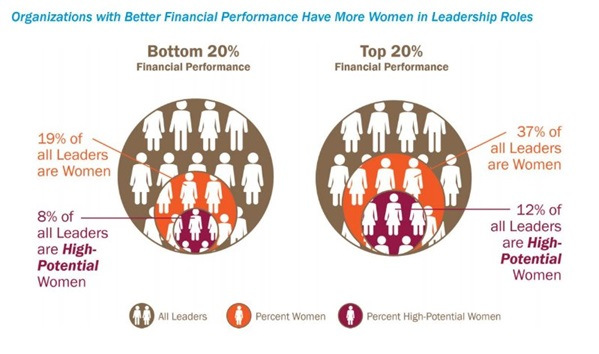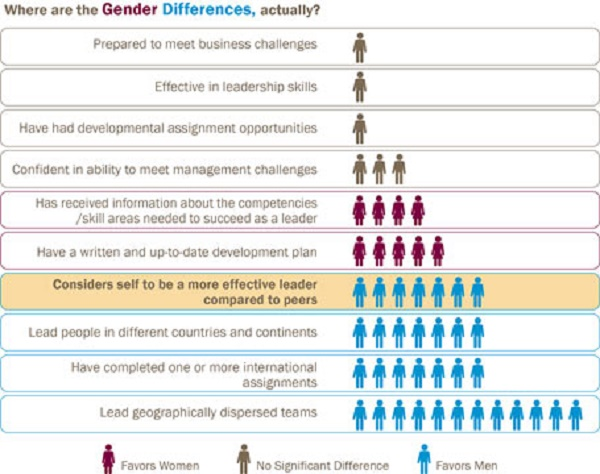ATD Blog
Gender Diversity Among the Ranks of Leadership Pays Off
Wed Jul 22 2015

We know that stepping up as a manager is one of the most courageous decisions in a person’s career. Yet, 2014 research from the DDI report Leaders in Transition found that more than 87 percent of first-time leaders feel frustrated, anxious, and uncertain about their new role.
Indeed, too often, first-time managers are left to sink or swim, trying to navigate the waters of their first management role without direction, development, or any knowledge of the dos and don’ts of formally managing a team. What's more, 42 percent of those new leaders around the globe who are moving through this transition are women, according to data from The Global Leadership Forecast 2014|2015 (GLF) from DDI and The Conference Board. Although more women graduate from college than men and are earning entry-level jobs in fields previously dominated by men, women are still outnumbered in the ranks of leadership.
At the same time, the business case for gender diversity has never been stronger. That same global study found that organizations with more women consistently perform better financially. Companies in the bottom 20 percent of financial performance had only 19 percent women in leadership positions; companies in the top 20 percent have 37 percent female leadership.

What’s Holding Women Back?
Interestingly, even though women are under-represented in the leadership ranks, a lack of competence isn’t the culprit. The GLF found that female leaders rated themselves as effective as males on an entire array of competencies. Multiple other studies show that female leaders are every bit as competent as their male counterparts. In fact, DDI’s own testing and assessment processes, which look at real behavior, not survey data, show little difference in gender leadership competence for over 10,000 leaders.
So, we dug a little deeper into the GLF data and learned that women cited a lack of opportunities to lead teams and to have global leadership experience—factors related to career advancement. This information begs the questions: Are women turning down opportunities given the travel requirements associated with a global leadership experience and the impact on family? Do they lack confidence to stretch into a larger role with more responsibility? Unfortunately, there aren’t clear answers to these questions.
Authors Claire Shipman and Katty Kay—both prominent broadcasters—point out in their book The Confidence Code that confidence is a key differentiator. A quote from their book sums up the situation: “Men think they can and women think they can’t.” The GLF echoes this theme with women tending to rate themselves as less effective as a leader than their male peers.

Not convinced yet? Recently, Real Simple/Time released its Success Poll. They surveyed 1,000 women on how they define success, how much importance they attach to success, as well as the risks they’ve taken to achieve it. Their polls revealed that only 8 percent of women consider themselves a success all the time. And, 36 percent of women often feel others at work think that they are more qualified than they think they really are.
So, what women leaders need is an attitude change—or a different set of voices guiding the way. A great voice is Sheryl Sandberg, who writes in Lean In: Women, Work, and the Will to Lead_: "_Women need to shift from thinking ‘I'm not ready to do that’ to thinking ‘I want to do that—and I'll learn by doing it.’”
The Wisdom of Women (and Madonna)
In Your First Leadership Job, co-author Rich Wellins and I had some four dozen conversations with top women around the globe. Based on these interviews, here is some advice for women on the ascent up the corporate ladder.
Fail often, fail well. Know and understand what is important to you, and be very clear on the goals you want to achieve. However, don’t be afraid to fail along the way. “Success is about working out what you want to do, not necessarily driving for the name or title, but more about the richness of what you’re doing.”
Find someone who believes in you even more than you believe in yourself. These mentors and sponsors will be able to provide you with insight, guidance, and advice—and even challenges you haven’t yet encountered. “Make yourself meet these people, and continue to meet them within the organization,” because if you choose the right ones, they will back you when you need it most.
Show your value, stand out. Demonstrate results and make them visible. However, take note that doing a good job is not defined by long hours, but by the outcomes you deliver. “Earning respect and doing a good job of what you do gets you a long way.”
Be “Madonna-like” and Vogue. I challenge you to channel your inner rock star—in this case—Madonna. Madonna and performers of all types have mastered the ability to walk out on the stage with an air of confidence. Were they born this way, or did they develop this skill? It is likely that the confidence they project to the audience was developed over time. As a young singer, Madonna most likely was scared silly on the inside, but didn’t let those emotions show on the outside.
Consider how this can help you. If you begin to put this into practice, you’ll see true results. And you won’t be alone. Eight percent of women strike a “power pose” to get pumped for a meeting, according to Real Simple/Time. It’s a bit of a cheat, but it works. If you strike a power pose before an important meeting or conversation, you will feel more powerful. Get pumped! Every meeting is an opportunity. Join the women leaders who know their power.
So take a chance, seek a mentor, and strike a pose—and others will see you as poised, credible, and confident. In turn, you’ll build your own inner confidence to stretch, grow, sometimes fail, and overall learn.
Editor’s Note: This blog originally appeared on DDI's Talent Management Intelligence, DDI’s blog for talent management professionals.
You've Reached ATD Member-only Content
Become an ATD member to continue
Already a member?Sign In
